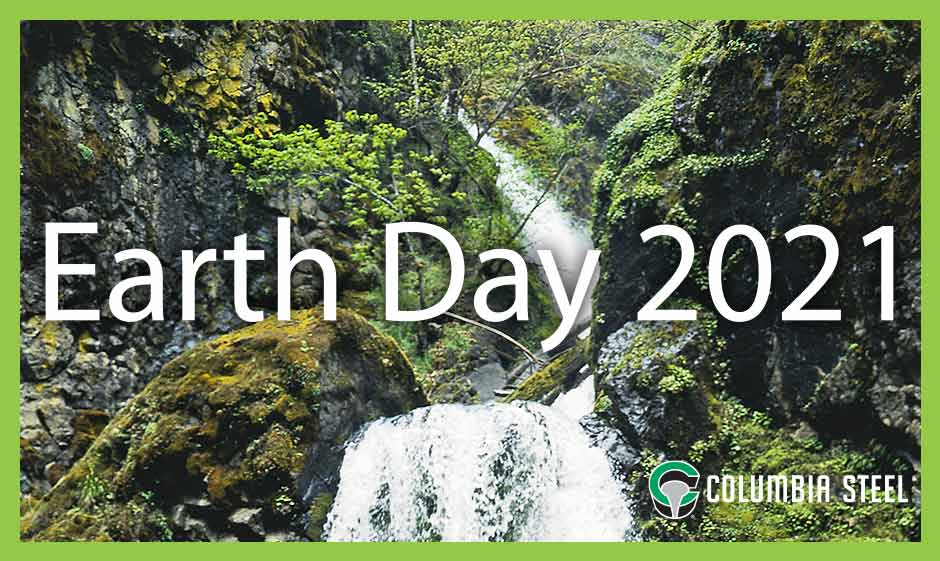Our Water Conservation Initiatives Reduced Consumption by 98%.
In 1970, more than 20 million Americans gathered to observe the first Earth Day and advocate for a cleaner, greener world. While those values are widely shared today, at the time it seemed a distant dream for many. That wasn’t true at Columbia Steel. In our little corner of the city, preserving the natural world has been a guidepost long before environmentalism and the Earth Day movement burst into the national consciousness.
Way back in 1938, we installed a dust collector, which, according to company folklore, was the first of its kind west of the Mississippi. This and other company initiatives, which typically surrounded appreciating our foundry’s natural setting, earned us recognition at the state level when Oregon Governor Bob Straub presented Columbia Steel with an environmental leadership award in 1975.
In the early 80s, with decades of environmental leadership already at our backs, we set out on an ambitious, multi-year plan to reduce our water consumption. This project would become one of the most successful environmental upgrade efforts in company history and set the tone for our approach to environmental stewardship that continues to this day.
Not Satisfied with the Status Quo
Water usage had long been a concern at Columbia Steel because foundries like ours traditionally require an astonishing amount of water to operate. Before our water conservation project, we used city water in many of our processes. We could either accept this high water usage as a cost of doing business or search for a better solution. Our leadership team understood that addressing water consumption was the right thing to do both from an environmental and business standpoint. So, beginning in the early 1980s, we launched a multi-phase water recycling plan that we hoped would eliminate our plant’s discharge of process water.
A Plan to Reduce Water Consumption
The project began in earnest in 1981 when we built a foundry extension with a brand-new 10-ton furnace. Instead of using a traditional system that constantly brought in new city water to cool the furnace, we installed a closed-looped cooling tower to recycle the furnace cooling water. Some of the water in our closed-loop system is naturally lost through evaporation as it cools, which we replace with a small amount of city water.
We then built a quench system that used recycled water to cool our heat-treated castings. Rather than using city water to replenish this cooling system, we rely on a combination of well water and rainwater runoff collected from our building’s roofs in a closed loop recycling system. A decade later, a second quench system was also upgraded in another building to expand the closed loop system.
While these steps drastically reduced our water usage, we continuously found additional means to reduce water consumption. For instance, the default method of cooling air compressors to operate molding machines, power tools and sand conveying systems was with water rather than air. That meant these systems all used a tremendous amount of water. We began replacing that equipment with air-cooled compressors in the 1980s. Because we rely so heavily on compressed air, the move towards air-cooled compressors significantly impacted our overall water usage. At the same time, we began transitioning our four air-conditioning compressors to air-cooled alternatives.
As we moved through our water recycling plan, we looked for every opportunity to reduce consumption. Even the city water we use in our pressure washers flows into an underground tank where it undergoes an oil-water separating process. The clean water is then pumped into a storage tank with the well and rainwater runoff for cooling heat-treated castings. The small amount of oil we recover goes into a tank and is then collected by a licensed recycler that refines it for other purposes.
While our water recycling efforts began in isolated areas, they soon blossomed into a broader company value. Today, anytime we expand our plant or add a new piece of equipment, water usage and recycling are always a primary consideration.
The Results Were Immediate
We saw immediate results from these environmental upgrades. By 1992, we’d reduced our water consumption by 98%. Our recycling efforts eliminated city water from our manufacturing process to the point where it’s used only for bathrooms, showers and coffee pots. By 2000, our cost of water and sewer bills was the same as in 1978, despite a 300% increase in production. Meanwhile, there was a 2,300% increase in rates. Our upgrades enable us to be a certified non-discharger of industrial wastewater. In all, our recycling efforts save 500 million gallons of water annually that would otherwise flow into the public sewer systems.
Not only do these upgrades protect the natural environment, but they also keep our company financially healthy. Because we don’t release wastewater into the environment, we don’t have to purchase expense discharge permits and potential treatment systems. We also avoid paying large ongoing utility bills for excessive water consumption. We can funnel these savings back into the business to make further improvements while also investing in our employees. Environmental upgrades are not a zero-sum game. Instead, when implemented with thought, care and ingenuity, these upgrades can deliver actual bottom-line results.
Doing Our Part to Protect Our World
In April 2000, near the 30th anniversary of Earth Day, Columbia Steel received The City of Portland’s Businesses for an Environmentally Sustainable Tomorrow (BEST) award for our water conservation accomplishments. In the years since, we’ve launched new initiatives to reduce our environmental impact, like our recycled sand and slag program. Most importantly, the birds, fish and other wildlife continue thriving in the wetlands around our plant, undisturbed as we go about our work. We hope that these efforts will help Portland and St. Johns remain clean and beautiful for years to come.
